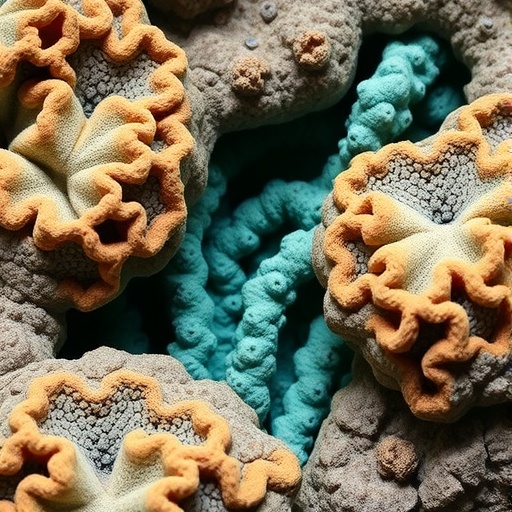In a groundbreaking study recently published, researchers have unveiled significant findings regarding the seasonal biogeochemical variations in a modern microbialite reef, drawing parallels to early Earth-like conditions. This innovative research not only sheds light on microbial ecosystems but also holds implications for our understanding of Earth’s ancient environments and the evolution of life. The microbialites studied are structures formed by the activity of microorganisms, particularly cyanobacteria, which play a crucial role in nutrient cycling and contribute to the formation of complex reef systems.
The research team, led by F.A. Vignale alongside co-authors L. Sánchez-García and D. Carrizo, undertook an elaborate investigation of the microbialite reef located in one of the world’s most pristine marine environments. They meticulously collected data over multiple seasons, observing how environmental variables such as temperature, light, and nutrient availability influenced the biogeochemical processes within the microbial communities. This work emphasizes the dynamic nature of these ecosystems, highlighting the sensitivity of microbialites to fluctuations in their surrounding environment.
A particularly striking aspect of the study is the revelation of how microbialite reefs function as living archives of environmental changes. By analyzing stable isotopes and carbon cycling pathways, the researchers were able to reconstruct the historical conditions under which these microbialites thrived. This reconstruction provides an unprecedented window into the early Earth, offering clues about microbial life during a time when the planet was drastically different from what we know today.
Throughout their research, the team discovered that seasonal variations had pronounced effects on the productivity and metabolic activities of the microbial populations inhabiting the reef. During warmer months, biomass increased significantly, driven by enhanced photosynthetic activity of cyanobacteria and the availability of light. In contrast, colder months triggered shifts in nutrient cycling, underscoring how microbial communities adapt to seasonal changes in their environment. These findings illustrate the resilience of such ecosystems, as well as their capacity to thrive under varying conditions—much like the early Earth.
As the researchers examined the microbial community composition, they identified a diverse array of taxa, each contributing uniquely to the biogeochemical cycles. This biodiversity is crucial for maintaining ecological balance within the reef. The presence of different microbial groups not only enhances nutrient utilization but also fortifies the structural integrity of microbialites against external stressors, including pollution and climate change.
Methodologically, the study employed advanced techniques in metagenomics and stable isotope analysis to obtain a comprehensive view of microbial activity within the reef. By integrating these high-throughput sequencing methods with classical biogeochemical assessments, the researchers were able to correlate specific microbial taxa with functional capabilities. This integrative approach is paving the way for future investigations into how similar microbial processes could operate on other celestial bodies, such as Mars or Europa, where conditions may have evoked parallels to early Earth.
Moreover, the implications of this research extend beyond academic curiosity. Understanding the functional capacities of these microbial communities is vital for developing strategies to restore and manage coral reefs and other biomineralized ecosystems that are currently under threat. The interactions observed in microbialite reefs exemplify the intricate relationships between microorganisms and their environments, underscoring the need for conservation efforts that prioritize the health of microbial ecosystems.
As climate change continues to pose significant challenges to marine ecosystems worldwide, the insights gained from studying microbialite reefs offer crucial data. The seasonal responses of these reefs could serve as predictive models for understanding how various ecosystems might respond to ongoing environmental changes, such as increased ocean temperatures, acidification, and nutrient loading. In this regard, microbialites are not only scientifically intriguing but also potentially vital indicators of ecological resilience.
In light of the findings from this study, the researchers advocate for increased monitoring and preservation efforts around microbialite formations. These ancient structures, often overshadowed by more charismatic marine life, are critical to the functioning of their ecosystems. By recognizing their value, we can work toward protecting these ecosystems against degradation due to human activities and climate change.
In conclusion, this research marks a significant leap forward in our understanding of microbial ecology and the historical evolution of Earth’s environments. The profound connections established between microbial communities and their environmental contexts reveal layers of complexity that define microbialite ecosystems. By navigating the intricate interplay of biology and geology, this study opens new avenues for inquiry into both microbial life on Earth and the potential for life elsewhere in the cosmos. The lessons learned from these microbial reefs are invaluable, providing not only a glimpse into the ancient past but also guiding future research and conservation practices.
As scientists continue to piece together the puzzle of our planet’s early conditions and the life forms that once thrived in radically different environments, studies like these serve as beacons of knowledge. They illuminate the resilience of life and the intricate web of interactions that sustain these critical ecosystems, urging the scientific community to appreciate and protect these living relics of our planet’s evolutionary history.
Understanding the significance of these findings cannot be overstated. They serve as both a scientific contribution and a call to action to safeguard the microbial worlds that have persisted through millennia. Moving forward, it is imperative that we collectively recognize the importance of such ecosystems in shaping not only our planet’s past but also future environmental management and biological exploration.
Subject of Research: Seasonal biogeochemical variations in microbialite reefs.
Article Title: Seasonal biogeochemical variations in a modern microbialite reef under early Earth-like conditions.
Article References: Vignale, F.A., Sánchez-García, L., Carrizo, D. et al. Seasonal biogeochemical variations in a modern microbialite reef under early Earth-like conditions. Commun Earth Environ 6, 751 (2025). https://doi.org/10.1038/s43247-025-02764-6
Image Credits: AI Generated
DOI:
Keywords: Microbialite reefs, biogeochemical cycles, early Earth, microbial ecology, climate change, ecosystem resilience.




